Kenmore-Town of Tonawanda UFSD
Our Vision: A community that creates dynamic learners who possess social awareness, confidence, and a belief in their power to succeed.
- Kenmore Town of Tonawanda UFSD
- District History
-
The Story of Ken-Ton Schools
Written by Patrick Fanelli & Trevor BrownIn fall 1892, a new school opened at the corner of Delaware Road and Delaware Avenue where the Tonawanda Municipal Building now stands. This was the Kenmore Union School, and it was built on the outskirts of what would soon become the Village of Kenmore, one of the earliest suburbs in America.
At the time, the City of Buffalo was thriving as a commercial, transit and industrial center, and innovations in transportation and homebuilding were making the dreams of suburban life possible. With the rapid growth of Kenmore and other nearby communities, the need for schools grew fast.
The Kenmore-Town of Tonawanda School District as it is today took shape with the consolidation of several smaller school districts in the 1920s and 1930s. The history of Ken-Ton Schools would be shaped by the trials and triumphs of the 20th Century and surging student enrollment as the Village of Kenmore and Town of Tonawanda quickly became Buffalo’s most populous suburban communities. Visit the About Us Page to learn more about the Ken-Ton School District today.
Have anything to add? Contact Patrick Fanelli, Director of Communications, at pfanelli@ktufsd.org.
Table of Contents:
Ken-Ton Schools in the 19th Century
Early Growth in the Town & Village (1900-1920)
School Districts Consolidate (1920s)
School Expansion in the Roaring Twenties (1920-1929)
The Great Depression and World War II Years (1930-1945)
Rapid Development in the Post-War Era (1945-1970)
No More Room for Growth (1970s and 1980s)
This circa-1888 photo of a class led by instructor Ida Zimmerman was taken in front of the old School House #4 located at the northern end of Delaware Road.
Ken-Ton Schools in the 19th Century
The Town of Tonawanda was originally under Seneca control until it came under the ownership of the Holland Land Company in the early 19th Century. The town was remote and difficult to get to, making it sparsely populated at the time. The work of Joseph Ellicott, who was hired by the Holland Land Company to survey the town and design some of its earliest roadways, had a significant impact on the town in the early 1800s. So, too, did the opening of the Erie Canal in 1825. The canal was dug along the Niagara River shoreline in order to connect Ellicott Creek with the canal’s terminus in Buffalo to avoid the swift river currents. Much of the town’s early growth was due to canal traffic.
For early settlers in what would later be incorporated as the Town of Tonawanda, education was a function of the family, and farm life left little time for formal schooling. That began to change in the mid-1800s. Several one- or two-room school houses were operating in the town after the Civil War, though children often had to walk long distances along dirt roads or through woods and fields to get to school. There were five school houses documented in the following locations:
- On Two Mile Creek Road just south of what is now Grand Island Boulevard (identified as School House #1)
- On River Road where the South Grand Island Bridge now stands (identified as School House #2)
- At the northern end of Delaware Road (identified as School House #4)
- Present-day corner of Eggert and Fries Roads (unidentified school house)
- Present-day corner of Englewood and Cortland Avenues (unidentified school house)
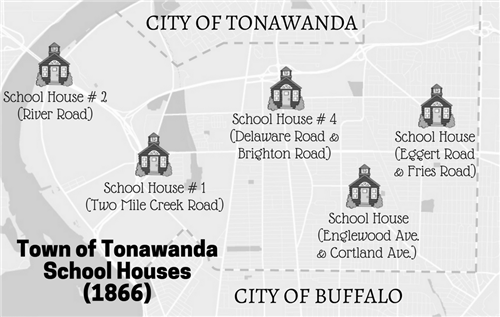
The locations of the five school houses documented in the Town of Tonawanda in 1866.
The town was sparsely populated at the time and little more than a wide expanse of farmland and empty fields between the sprawling urban landscape of Buffalo to the south and what would soon become the City of Tonawanda along the Erie Canal. For a while, the Town of Tonawanda's five school houses were enough to meet the needs of local families. Attendance was sporadic, as the needs of the family came first. But the need for schools began to increase in the late 1800s when school attendance became mandatory in New York State and as more and more people moved into the town. This was especially true in what would become the Village of Kenmore.
In the 1880s, Buffalo realtor Louis Phillip Adolph Eberhardt envisioned a community close enough to Buffalo that residents would be able to commute to work via public transportation but far enough away that families could still enjoy a quiet semi-rural lifestyle. It was Eberhardt who acquired and developed the tract of land that would become Kenmore. It was also Eberhardt who chose the name "Kenmore," the proposed name of a new train station under construction in North Buffalo which would be a gateway for the village (though the station would ultimately bear the name "Kensington").
Kenmore was among the earliest suburbs in the nation, and the very first community of its kind in Western New York. New homes were built here at a rapid pace in the 1890s as the recent expansion of transportation services into the town enabled more and more people to live outside the busy, crowded neighborhoods of Buffalo. Construction innovations were also enabling homebuilders to quickly meet the demand for new houses.
The old Kenmore Union School at the corner of Delaware Road and Delaware Avenue. The school operated from 1892 to 1911, when it became the new town and village hall.
A photograph looking north on Delaware Avenue in the early days of Kenmore, which consisted of only a handful of newly constructed homes. The recently completed Kenmore Union School can faintly be seen in the distance.
A school was needed in Kenmore as residents flocked to the new community. In 1892, a two-story wooden school building was constructed on the outskirts of the village at the corner of Delaware Road and Delaware Avenue, the present-day site of the Tonawanda Municipal Building. This was School #6, also known as the Kenmore Union School. Until it closed in 1911, the Kenmore Union School served families in Kenmore as well as the nearby hamlet of Ellwood and farther away in Kenilworth. Celia Marsh, the wife of a local pastor, was the very first principal of the school. It opened for the term beginning in fall 1892.
In 1908, the University of the State of New York certified the Kenmore Union School as an academic institution of the Union School District No. 1 of the Town of Tonawanda, which later became Union Free School District No. 1. Schools would operate under this name until 1973 when the name was formally changed to “Kenmore-Town of Tonawanda Union Free School District.”
The graduating eighth-grade class of Kenmore Union School in 1910 in the final year before the school closed. Jane V. Towne, front row, center, would be the district's very first high school graduate.
Early Growth in the Town & Village (1900-1920)
There was a need for new schools elsewhere in the Town of Tonawanda at the turn of the century as well. In 1907, a small school was built in the neighborhood now known as Elmwood North on the corner of School Street and Elmwood Avenue. This replaced the old School House #4 at the northern end of Delaware Road. Around this time, a school was constructed in the Kenilworth area along Kenmore Avenue, where a 4,000-seat racetrack had been constructed. With industry drawing residents to the western portion of the town near the Niagara River, another small school was built in the neighborhood now known as Old Town in the Riverside area in 1909.
Meanwhile, largely because of the rapid growth in Kenmore, the Kenmore Union School was soon filled to capacity. In 1911, another school, named Kenmore High School, was constructed across the street at 1 Delaware Road. This three-story brick building, with separate entrances for boys and girls, was intended to be a place of learning for students of all ages in Grades 1-12. After the construction of Kenmore High School in 1911, the old Kenmore Union School building became the new town and village hall.
Kenmore High School (later George Washington Elementary School) before and after the 1916 expansion.
Kenmore High School was the first high school in town, providing a secondary education for students throughout the Town of Tonawanda, including the more rural areas. Prior to the opening of Kenmore High School, older children in the town and village had very little opportunity to pursue a secondary education. Those who did had to travel to schools in the City of Tonawanda or Buffalo. William C. Urham was the first principal of the school. In 1913, Kenmore High School honored its very first graduate, Jane Towne, the sole member of the graduating Class of 1913. Miss Towne can be considered the very first high school graduate of the Ken-Ton School District.
In addition to providing classroom space for high school students, the new school building replaced the old Kenmore Union School as the elementary school for children in Kenmore. Like its precursor, the new school also served students in Ellwood and Kenilworth. Enrollment at Kenmore High School increased so fast that, by 1916, a twelve-room addition had to be built onto the existing structure. This added two new wings to the front of the building.
Though the old Kenmore Union School building would be demolished in the 1930s to make way for the Tonawanda Municipal Building, some of these early school buildings still exist today. The old School House #4 that stood at the end of Delaware Road was moved down the street to Traverse Boulevard and converted into a residential home. The original Kenmore High School at 1 Delaware Road later became George Washington Elementary School and is now part of a prominent residential and commercial development. And the old four-room school building on the corner of School Street and Elmwood Avenue, which dates back more than 100 years, is now part of a privately-owned fitness facility.
This was a time before automobiles became commonplace when most of the town was still rural. For those living farther away, getting to school was still a challenge. Few roadways were paved and would often be impassable in the winter. Most students walked to school, though a few traveled in horse-drawn carriages. For a time, children in Kenilworth and Ellwood would crowd into a single uncomfortable bus driven by a man named Frank Reuter to make the two-mile journey to schools in Kenmore. They nicknamed it the "Ham Wagon."
Overcrowding was another common problem. The population was growing so fast that schools could not keep up with the demand for teachers and classroom space. Also, pursuing a secondary education was becoming more and more common among older children, increasing the need for classrooms at the high school level.
An aerial view of the Kenmore area in 1924.
School Districts Consolidate (1920s)
Until the 1920s, the Town of Tonawanda was divided into five individual school districts, each of which served the needs of its residents. The largest by far, District No. 1, operated the schools in Kenmore and extended out to Ellwood and Kenilworth. Four smaller districts encompassed the more rural parts of the town:
- District No. 2 and No. 3: Western portion of the town (including the neighborhoods now known as Old Town and Riverview)
- District No. 4: Northern portion of the town (including the Elmwood North and Paramount area)
- District No. 5: Northwestern portion of the town (Brighton)
These districts would ultimately consolidate as part of District No. 1, which would later be renamed the Kenmore-Town of Tonawanda Union Free School District.
The designation "Union Free School District" goes back to the 19th Century, when school districts in New York State were authorized by the State Legislature to operate elementary schools up to eighth grade but were not authorized to operate high schools. In 1853, the State Legislature authorized two or more districts to join together (thus forming a "union" between the districts) and operate a high school (thus "free" of the previous restrictions). These were called "Union Free School Districts."
The process of consolidating the smaller districts of the Town of Tonawanda into District No. 1 took place in the 1920s. Proponents for district consolidation, especially those in Kenmore, argued that it would provide an expanded tax base to address issues such as the ever-increasing need for classroom space throughout the town, as well as residents’ proximity to school buildings. Also, New York State education officials preferred to consolidate smaller districts into larger ones at the time.
Not everyone was in favor of the plan, though. Many residents on the eastern side of town, especially those in Kenilworth who were farther away from the schools in Kenmore, advocated for an alternate plan. This plan would have created two school districts instead of one, dividing the town in half. Some residents in District No. 2 and No. 3 in the western part of the town, which had recently combined for the purposes of constructing a new school building (the Warren G. Harding School), also favored independence. But the option to create one district was ultimately approved by the New York State Education Department and initiated for the 1926-27 school year. Only District No. 5 in the Brighton area would remain independent until 1938.
An early principal of Kenmore High School, Frank C. Densberger, who replaced William Urham, would become the very first Superintendent of the consolidated Union Free School District No. 1 and would continue in this role until 1953.

Frank C. Densberger, who served as Principal of Kenmore High School and then Superintendent of Schools from 1915 to 1953. Denserberger's portrait, along with all those who have served as Superintendent, hangs in the Administration Building at 1500 Colvin Blvd.
Union Free School District No. 1 would encompass the entire Town of Tonawanda with the sole exception of a small area in the northeastern corner of the town. Today, this is part of the Sweet Home Central School District. Initially, this area was sparsely populated, and early residents on the southern banks of Ellicott Creek were far away from the schools in Kenmore and the Town of Tonawanda. They lived closer to schools in the City of Tonawanda or northwest Amherst. Most of what is now the neighborhoods of Green Acres North and Parkview would be developed in the post-World War II era after the present-day Kenmore-Town of Tonawanda Union Free School District boundaries had already been established. In 1950, this area would be included as part of the newly consolidated Sweet Home Central School District. However, an issue related to property tax assessment and tax rates would temporarily lead many residents in this area to petition to join the Kenmore-Town of Tonawanda Union Free School District in the 1980s.
A chemistry class led by teacher Carl Baisch in 1924. Mr. Baisch would succeed Frank C. Densberger and become the second superintendent of the Kenmore-Town of Tonawanda School District in 1953.
School Expansion in the Roaring Twenties (1920-1929)
Kenmore and the Town of Tonawanda were thriving, and student enrollment continued to grow during the prosperous Roaring Twenties as the districts of Kenmore and the Town of Tonawanda consolidated. The quality of the schools was a big reason why the town and village became such a desirable place to live.
By 1923, a total of 763 students in Grades 1-12 were crammed into the old Kenmore High School building at 1 Delaware Road. In January of that year, the Board of Education presented a proposal to construct a new three-story junior/senior high school three-tenths of a mile up the street at 155 Delaware Road. The proposal was approved and construction began at a cost of $495,000.
The building was nearing completion as the 1924-25 school year began. Seventh- and eighth-grade classes finally moved into the new building in early November of 1924. Then, during a ceremonial event on November 17th, the high school students marched up Delaware Road and were welcomed to their new school by Superintendent Densberger. Kenmore Junior/Senior High pioneered several concepts which were considered to be innovations at the time including guidance, multi-track grouping of pupils, early foreign language study, student government, and extensive extracurricular programs. The junior/senior high school model itself was a relatively new concept. The building also included many impressive features for the time including a large gymnasium, swimming pool, and 1,100-seat auditorium.
An aerial photograph of Kenmore shows the newly constructed Kenmore Junior/Senior High School (later Kenmore Middle School) before it was expanded, doubling its size.
Four sports were offered when the school first opened in 1924: boys and girls basketball, track, and football. Kenmore teams were always a formidable opponent. The football team went undefeated in 1924 and the boys basketball team made it all the way to the NYS Championship the following year. In the school's early years, the football team had to play on an often muddy field with inadequate facilities for spectators. That all changed in time for the 1927 season with the completion of the future Crosby Field. It was named after Lt. Harry E. Crosby, one of two Kenmore residents who died fighting in World War I a decade earlier. Lt. Crosby fought with the 108th Infantry Regiment in Belgium and France toward the end of the war. In 1917, the regiment was fighting as part of the 27th Division alongside the 4th British Army in the Somme region, part of an operation that pierced the Germans' infamous Hindenburg Line. Lt. Crosby was charging a German machine gun nest when he was killed. He was one of 1,763 casualties, including 331 dead, out of the 3,056 soldiers of the 108th in just three months of fighting (a casualty rate of 58%).
Other schools were built during this time as well. The former Warren G. Harding Elementary School at 54 Riverdale Ave., which is now home to the Northtowns Boys & Girls Club, opened in 1921 to accommodate families in the former District No. 2 and No. 3 in the western part of town. The former Abraham Lincoln Elementary School on the corner of Wendel Avenue and Cambridge Street, now the Stanley G. Falk School, opened just three years later in 1924. This school was built to accommodate families in Kenilworth and Ellwood and in part to satisfy opponents of district consolidation on the eastern side of town, who lived farther away from the schools in Kenmore.
Early on, schools in Kenmore and the Town of Tonawanda had a reputation for excellence. This was evident in 1925 when Ken-Ton welcomed a very special guest to the community: Helen Keller, accompanied by Anne Sullivan Macy, who spoke in the Kenmore Junior/Senior High School auditorium. It was a proud moment for the young district.
Kenmore High School's undefeated football team in 1924, the year Kenmore Junior/Senior High School opened.
Even though construction of Kenmore Junior/Senior High dramatically increased district capacity, it wasn’t nearly enough to keep pace with the growing population and there was a need for more space within only a few years. In 1928, construction began on a massive addition to the school which more than doubled its size. It also included a new gymnasium with balcony seating, which became affectionately known as the Pit.
Washington Elementary was also becoming overcrowded. In 1928, the former Theodore Roosevelt Elementary School, which remained in operation until 2016, began to serve children on the western side of the booming Village of Kenmore. A couple years later, the eastern side of the village celebrated the opening of Charles Lindbergh Elementary School, which is still in operation today.
The Kenmore Junior/Senior High School marching band in 1938 under the direction of Carl Hann. Two years later, the new Kenmore Senior High School (now Kenmore West) would open less than a mile up the street.
The Great Depression and World War II Years (1930-1945)
Like most communities, people in Kenmore and the Town of Tonawanda were deeply affected by the Great Depression. In addition to the everyday hardships faced by residents, the economic downturn had a significant impact on school district revenue and budgets. The Board of Education and district administrators had to make very difficult decisions including lay-offs and salary reductions.
During this time, the Ken-Ton School District grew at a slower pace than before. The construction of new homes slowed in the early- to mid-1930s, and the population of the school district remained fairly steady. The Roaring Twenties had been a time of significant school construction and expansion, and for a while, there was adequate space for students and no need for additional schools.
But this soon began to change. The pace of new home construction began to speed up in the mid- to late-1930s. Also, in 1938, the addition of the old District No. 5 in and around Brighton brought many new students into the district. Economic conditions were improving and student enrollment was growing again. In 1936, continued growth necessitated three elementary schools (Lindbergh, Harding, and Lincoln) retaining seventh and eighth grades instead of sending those students to the now-crowded Kenmore Junior/Senior High. Additionally, federal funds were available for large-scale construction projects as part of President Franklin D. Roosevelt’s New Deal. Because of these factors, the district initiated plans for a new high school building.
An early aerial photograph of Kenmore Senior High School (now Kenmore West).
In 1938, district officials were given an eight-week deadline to begin construction on the new high school in order to be eligible for a Public Works Administration (PWA) grant in the later years of the New Deal. The Board of Education chartered a small private airplane to transport Board President Lloyd Greer, architect William Kidd, and Superintendent Densberger to Albany to secure approval for the plans, and construction began in August of that year (the yearbook notes that the plane ran out of fuel while returning and had to make an improvised landing on Military Road). In 1940, Kenmore Senior High School, now Kenmore West High School, opened at 33 Highland Parkway. The building faced Highland Parkway instead of Delaware Road as originally envisioned because a homeowner along Delaware Road, in a house that has since been removed, would not sell his property at a price the district was willing to consider at the time. Meanwhile, the building at 155 Delaware Road became Kenmore Junior High School.
For decades, all Ken-Ton graduates would have walked the halls of at least one of these two schools on Delaware Road during their junior and senior high school years. The early students and faculty of Kenmore Junior/Senior High School gave rise to the district’s rich traditions and legacy which would be carried on at Kenmore Senior High School less than a mile up the street, and eventually, at Kenmore East High School as well.
After the onset of World War II, many former students and teachers, not to mention members of students’ families, joined the Armed Forces and served their country with honor and distinction. One household - the family of John and Marie Trimper, who resided on Riverdale Avenue in Old Town - had six brothers all serving in World War II at the time. All had attended Warren Harding Elementary School after it had opened in the early 1920s; three of the brothers were graduates of Kenmore Junior/Senior High School and two were early graduates of Kenmore Senior High School (now Kenmore West). At the time, the Kenmore-Tonawanda Committee for Boys in Service cited the family as having the largest number of brothers serving in the Kenmore area. All survived the war.
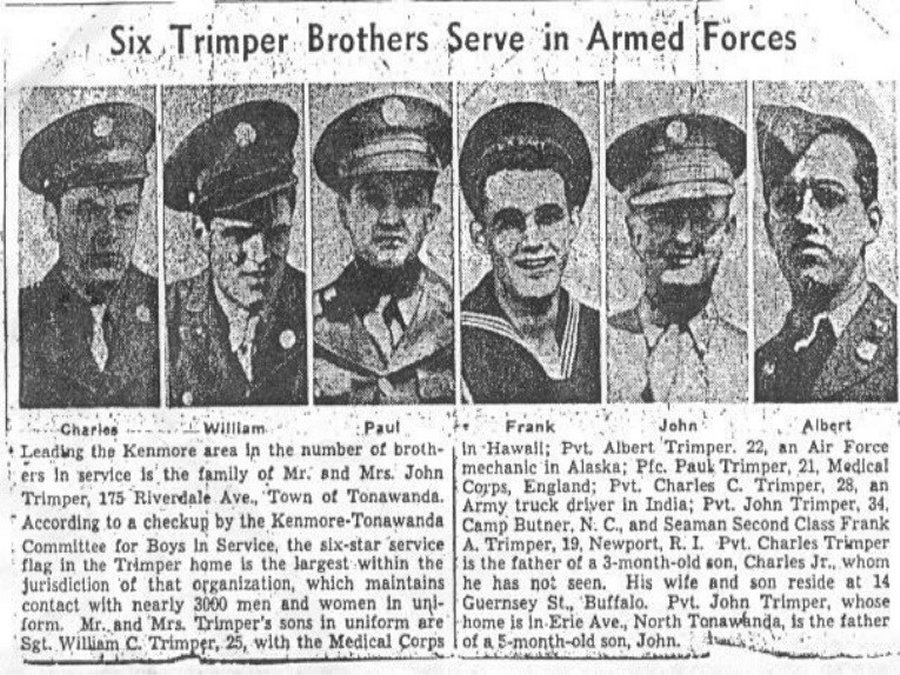
A newspaper clipping identifies the six sons of John and Marie Trimper of Riverdale Avenue in Old Town who all served in World War II at the same time. All had attended Warren Harding Elementary School after it opened in the early 1920s; three of the brothers were graduates of Kenmore Junior/Senior High School (later Kenmore Junior High/Kenmore Middle School) and two were early graduates of Kenmore Senior High School (now Kenmore West). All survived the war.
It was a time of rationing and shortages as the war in Europe and the Pacific raged on, and the collective efforts of all those back home supported the war effort in many ways. For instance, students at Kenmore Junior High School sold enough war bonds to sponsor a B17 Flying Fortress bomber which was named the “Spirit of Kenmore,” as well as a P-51 Mustang fighter plane which had "Junior Hi - Kenmore, NY" stamped on the side.
The war resulted in significant industrial expansion which brought many new workers to the area. A surge in student enrollment resulted in the construction of an elementary school in the Sheridan Parkside neighborhood in 1944, which would later be replaced by the former Sheridan Parkside Elementary.
Rapid Development in the Post-War Era (1945-1970)
In 1953, Frank C. Densberger’s 38-year tenure as leader of the Ken-Ton School District came to an end. Replacing him as Superintendent was Carl W. Baisch, a longtime teacher and administrator who had been with the district since its early days. In 1956, Baisch and other administrators moved from their offices at Kenmore Junior High School to the newly built Administration Building at 1500 Colvin Blvd. It was a time of extremely rapid growth in the district.
The population of Kenmore and the Town of Tonawanda increased at an extraordinary rate in the years following World War II as more and more of the town became developed for residential use. The school district became one of the fastest-growing suburbs in the country. The number of school-age children tripled in a very short period of time. Student enrollment increased from approximately 7,000 students in the mid-1950s to its peak of 22,500 students in the late-1960s. New school buildings had to be built at an astounding pace during this time to keep up with increasing enrollment.
An early aerial photograph of Hoover Elementary & Middle School.
This included Thomas Edison Elementary School, Oliver Wendell Holmes Elementary School, and the Benjamin Franklin and Herbert Hoover elementary/junior high school complexes, which are all still in operation today. Many other school buildings were built in the 1950s and 1960s to accommodate the extraordinary growth in student enrollment including the former Henry Longfellow, Thomas Jefferson, and Alexander Hamilton Elementary Schools, each of which have since closed but are still owned by the district. So, too, were many buildings that were later sold: Dewitt Clinton Elementary, Horace Mann Elementary, Robert Frost Elementary, Jane Addams Elementary, Betsy Ross Elementary, Green Acres Elementary, Brighton Elementary, Heritage Elementary, Philip Sheridan Elementary, and Sheridan Parkside Elementary.
The district needed a new high school as well. In 1959, Kenmore East High School opened its doors, and Kenmore Senior High School became Kenmore West. The geographical designation for the new building was chosen in favor of namesakes such as Frank Densberger or Harry Truman in order to maintain the historic name “Kenmore” in the school title. On Oct. 31, 1959, the brand new Kenmore East High School football team squared off against Kenmore West for the very first time, beginning a friendly cross-town rivalry that continues to this day. Parker Field (later renamed Adams Field, in honor of revered coach Richard "Sparky" Adams) wouldn’t open until 1970; in the meantime, Crosby Field would be home to both the Kenmore East and Kenmore West teams.
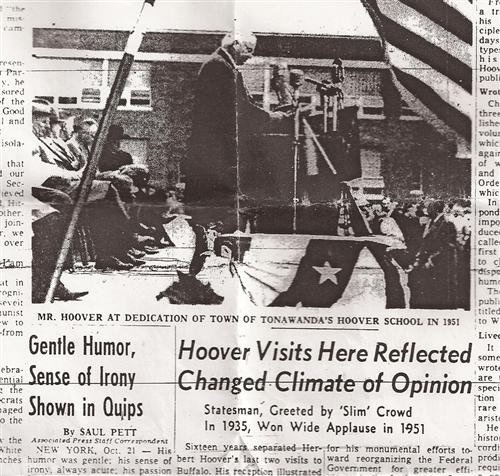
A newspaper clipping from former President Herbert Hoover's visit to Ken-Ton for the dedication of the Hoover Elementary and Junior High School.
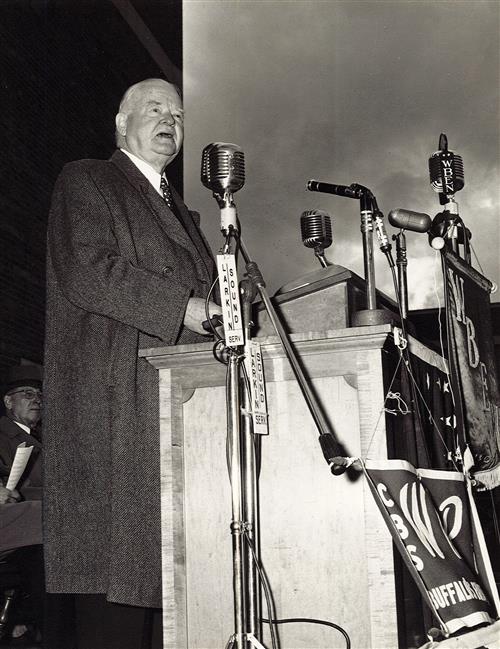
A photograph of former President Herbert Hoover speaking at the dedication of the Hoover Elementary and Junior High School.
The distinction of Kenmore-Town of Tonawanda Schools was well known by this time. On October 1, 1951, former President Herbert Hoover - in only his second visit to the Buffalo area - appeared in front of 7,000 people at the dedication of the Hoover Elementary and Junior High School complex. And in 1967, Jackie Robinson spoke to 900 people at a Franklin Elementary and Middle School PTA meeting.
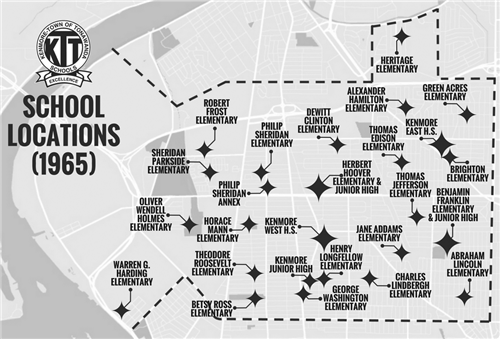
School locations circa 1965. Schools, particularly elementary schools, had been constructed at an astounding pace in the 1950s and early 1960s to keep up with the very sudden increase in school district enrollment as more and more of the town and village were developed for residential use.
No More Room for Growth (1970s and 1980s)
In 1968, voters rejected a $6 million bond issue to build a new 1,500-seat junior high school, the first defeat of a bond issue in the district’s history. It was around this time that student enrollment in the Kenmore-Town of Tonawanda School District began to decline.
The Village of Kenmore and Town of Tonawanda had developed so rapidly that, by 1960, there was virtually no land left in the town for new development. Many parents, who chose to make Kenmore and the Town of Tonawanda their home, remained after their children had graduated high school and moved on to college and careers. Many are still living in the town today. What resulted was a steady decline in student enrollment even as the school district population remained steady. The number of births in the town had reached its peak in 1955 and decreased each year after that. Eventually, student enrollment began to decrease gradually year by year, creating more and more underutilized space in the district’s expansive list of schools. It was an inevitable adjustment resulting from the suddenness and rapid pace of development during the prosperous post-war era.
Most of the schools that opened at such an extraordinary pace in the 1950s and 1960s had to be closed in the 1970s and early 1980s. By 1983, a total of 14 school buildings and two annexes had been closed. One of those schools, Thomas Jefferson Elementary, reopened in 1986 due to a surge in elementary school enrollment, though the school would eventually close again in 2013. Over time, a total of 15 of former school buildings were sold by the district and all but three are still standing and have been repurposed. Many of these buildings have become centers for municipal, recreation, social services, and senior programming. Beginning with the 1981-82 school year, grade level configurations were modified: ninth grade was moved to the high schools and sixth grade was moved to the junior high buildings, making them middle schools. Another adjustment in the district’s grade level configurations and inventory of school buildings took place beginning with the 2016-17 school year. A community-driven consolidation plan, which was two years in the making, resulted in the closure of three schools and the transition of fifth grade to the middle schools and eighth grade to the high schools.
Despite this decline in student enrollment, the Kenmore-Town of Tonawanda School District remains among the largest school districts in Upstate New York. As Kenmore and the Town of Tonawanda remain extremely attractive places to live, work, and raise a family, the district will likely once again have to address the challenges of rising student enrollment in the near future as more and more new families make Kenmore and the Town of Tonawanda their home. Of the three school buildings that closed in 2016, one has officially reopened (Kenmore Junior/Senior High, formerly Kenmore Middle, now the home of innovative Gr. 7-12 non-traditional programming) and one has reopened as the home of the district's thriving full-day Universal Pre-Kindergarten Programs (Hamilton Elementary).
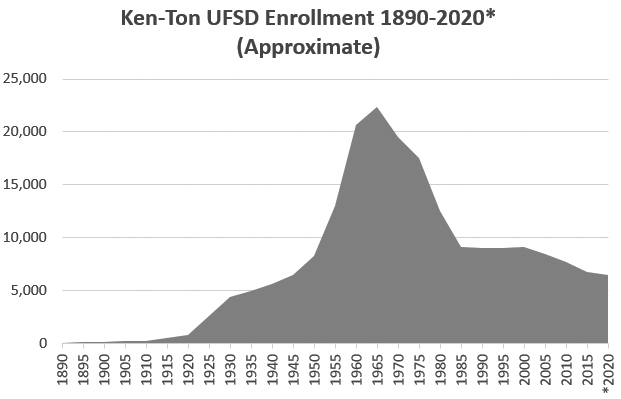
*Year 2020 enrollment based on 2020 enrollment projections.This chart shows approximate Kenmore-Town of Tonawanda Union Free School District enrollment from 1890 to 2020 (projected). The district experienced extraordinary growth during the 1950s and 1960s due to the rapid pace of development in the post-World War II period and the sudden influx of young families into the district during this time. Enrollment declined during the 1970s and 1980s as the average number of school-age children per household decreased.
District of Distinction
Dr. John "Jack" Helfrich served as Superintendent of Schools from 1981 to 1994. Dr. Helfrich is credited for ushering in a new era for Ken-Ton Schools, one of innovation and national prominence. He spearheaded two homegrown institutions that continue to play an integral role in our district today. One of those is the Mentor Program, which positions experienced and skilled educators to mentor new teachers who are at the start of their careers. The other is the Staff Development Center, which provides a framework for advanced training and professional development for Ken-Ton School District teachers and staff. Both were innovative initiatives that served as models for school districts throughout the state and nation.
Under Dr. Helfrich’s leadership, staff were proud to see their schools and district counted among the best in New York State and the nation. All but one of the district’s 13 schools were named New York State Schools of Excellence. Seven were named National Schools of Excellence, a distinction reserved for only a small fraction of the nation’s K-12 institutions. School and district representatives were even brought to Washington D.C. to be recognized and to celebrate their achievement.
In 1988, Dr. Helfrich was named the very first New York State Superintendent of the Year. In 1992, the Ken-Ton School District was awarded New York State’s very first Excelsior Award for Excellence in Education by then-Governor Mario Cuomo. Shortly following his retirement, Dr. Helfrich was the recipient of the Distinguished Service in Educational Administration Award from the New York State Council of School Superintendents, as well as the Excellence in Educational Leadership Award from the University Council for Educational Administration.
Numerous Ken-Ton alumni have achieved national and international prominence. Authors, actors, film producers, comedians, musicians, business leaders and other professionals who have achieved the highest levels of success in their careers count themselves among the proud alumni of the Kenmore-Town of Tonawanda School District.
Just a few notable examples include Edward Gibson, an astronaut aboard Skylab and a previous record-holder for individual time in space, who graduated from Kenmore Senior High School (now Kenmore West); CNN anchor Wolf Blitzer, an alumnus of Kenmore West, and CBS Evening News anchor Jeff Glor, an alumnus of Kenmore East; Jon Luther, former chairman and CEO of Dunkin’ Brands (operator of Dunkin' Donuts and Baskin-Robbins), and actor/comedian Paul Vogt (“MadTV”), both Kenmore East alumni; and Kenmore West alumnus Frank Easterbrook, who has served as a judge on the U.S. Court of Appeals for the Seventh Circuit since 1985 and as Chief Judge from 2006 to 2013, just to name a few.
The district's legacy of educational distinction has continued to this day. The district is known for its exceptional art and music education programs, extensive high school course offerings, and superb core academics. The district has a long history of athletic achievement, and high school teams have won numerous league, sectional and statewide titles. The district is also known for its innovative framework of mentoring, coaching, and staff development that has fostered a world-class teaching staff.
Ken-Ton is one of only two school districts in the eight counties of Western New York to offer the International Baccalaureate Program. In 2020, both high schools were among the top high schools in the U.S. to earn the "Best High Schools" designation in the U.S. News & World Report's Best High Schools rankings. Receiving very high marks for College Readiness (a measure of how prepared students are for post-secondary success) and College Curriculum Breadth (a measure of rigorous college-level coursework), both schools placed in the top 25th percentile of schools nationwide, outperforming more than three-quarters of the 17,790 high schools ranked in the U.S.
Sources:
Percy, John W. “Pioneer Suburb: A History of Kenmore, New York With Background on the Town of Tonawanda.” Kenmore, NY: Partners’ Press Inc., 1974.
Silsby, Robert W. “Settlement to Suburb: A History of the Town of Tonawanda.” Tonawanda, NY: Sterling C. Sommer Inc., 1997.
Percy, John W. “Tonawanda, The Way It Was.” Kenmore, NY: Partners’ Press Inc., 1979.

